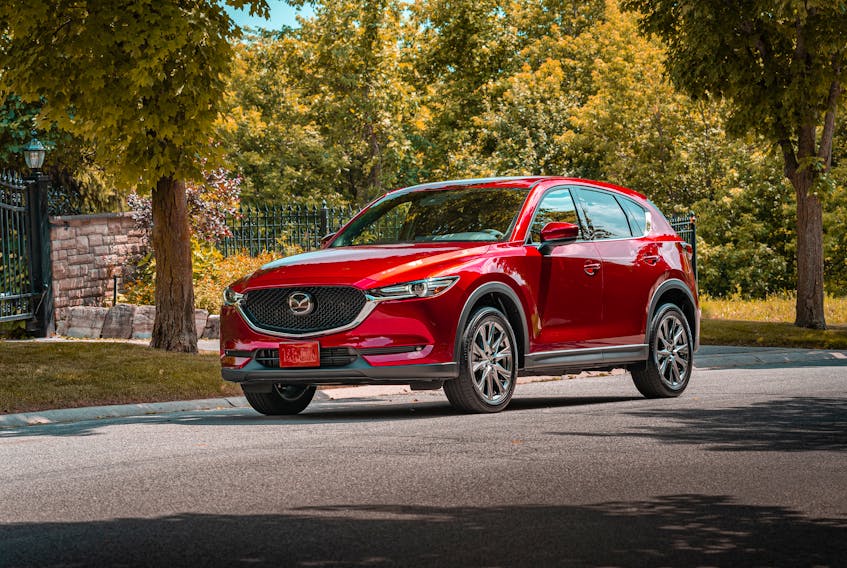At long last, long-awaited, finally available, perpetually postponed, it took a long time coming. No, we’re not talking about a new Guns N’ Roses album, 15 years in the making. These phrases can be found in any review of the diesel-powered 2019 Mazda CX-5.
Ten years ago, when whispers began about a diesel variant of Mazda’s top-selling crossover vehicle for the North American market, it made sense. Sales of vehicles fueled by diesel had been on the rise. The diesel engine was touted as more efficient, more durable, less harmful to the environment. Europeans had embraced the diesel engine, purchases of which used to command almost half the market. North Americans were slowly coming around to the diesel way.
Then, in the fall of 2015, the emissions cheating scandal broke, embroiling Volkswagen and other car companies in lawsuits and disgrace. The world was left with a bad taste in its mouth for anything diesel, providing an overwhelming reason for Mazda to stall its release of the diesel version of its CX-5.
Diesel sales numbers in Europe are seriously dropping. The first half of 2018 showed a 36.5 per cent share of the market compared to 42.5 per cent during the first half of 2017.
However, there are still diesel lovers out there.
That loyalty is in part what Mazda is banking on here in North America, especially during a time when most auto manufacturers are steering away from diesel and racing towards electrification. Not to mention, the much-improved economy of gasoline engines.
What is a diesel engine and how is it different than one fueled by gasoline? Gasoline engines use a spark plug to ignite an air-fuel mixture in an engine’s cylinder. The diesel engine, named after Rudolf Diesel, is also an internal combustion engine. Rather than igniting fuel with a spark, however, the air-fuel mixture is compressed in the cylinder, raising the temperature in the combustion chamber so high, that injected fuel ignites spontaneously.
The diesel engine has the highest efficiency of any internal combustion engine and was originally used as a replacement for the stationary steam engine. In the 1910s diesel engines began to be used in submarines and ships then in locomotives, trucks, heavy equipment and to power electricity generation plants.
It wasn’t until the 1930s that diesel engines began to be used in a few automobiles. They’ve been around for awhile.
I drove the CX-5 diesel for a week, doing what I usually do with a vehicle. I simply enjoyed driving it. Why? Well for one thing, it’s a sleeper. The only way you can tell it’s a diesel from the outside is the tailpipe and the Skyactiv-D badge on the tailgate.
One reason cited by non-diesel aficionados for sticking to gasoline is the noise of a diesel engine. I happened to like the ever-so-slight diesel ‘clatter’ and found it comforting like the gravelly voice of Rod Stewart. Driving the Mazda CX-5 Diesel made me feel purposeful, utilitarian. I was working, getting stuff done.
Joking aside, I had to actually listen for the sound to know it was there. Mazda has figured out ways to minimize the clatter. A mechanical mass damper is used inside each piston — reducing high frequency combustion sound at the source. For lower frequency knock noise, Mazda engineered a method that uses pressure wave cancellation to nullify the most severe combustion sounds. Injection events are minutely timed so that audible pressure waves cancel each other out.
To deal with the emissions, North American variants of the Skyactiv-D employ a complex array of after-treatment components in the exhaust to break down combustion byproducts so that clean emissions are assured without sacrificing performance.
Of course, when one is working and getting stuff done, one should look good. Mazda knows how to do that. With the gasoline-powered Mazda CX-5 receiving the Automobile Journalists Association of Canada’s 2018 award as being the Best Small Utility Vehicle in Canada, the CX-5 already has street cred.
Since reaching into the luxury SUV segment, Mazda has proven it can do understated yet elegant interiors. The ride and handling is definitely premium.
Unfussy to drive with well-mannered handling, solid steering and body control, the CX-5 Diesel, with its 168-horsepower 2.2-litre twin turbocharged four cylinder engine, feels sporty.
Torque-y — I realize that’s not a word, but it should be — fun is provided by 290 lb.-ft. of torque. There is also the unexpected improvement in towing capacity in the CX-5 — a seventy-five per cent increase from 2,000 to 3,500 lbs.!
This statistic sent me into a serious case of digital distraction, perusing the internet for those cool, new tech-y travel trailers, imagining a life on the road, a different sunrise every morning. Heck, I could get away from it all in this CX-5 Diesel!
Since fuel economy numbers are not exceptional — 8.9 L/100km in the city, 7.9 L/100km on the highway and 8.5 L/100km combined — and the diesel option for Mazda comes only in the top Signature trim and adds $5,000 to the purchase price, who, I wondered, will buy the Mazda CX-5 Skyactiv-D?
According to Mazda’s research and a recent market survey, 4,000 people said they would buy a CX-5 with Skyactiv-D 2.2-litre engine. Since 2016, 22,000 diesel SUVs and sedans have been sold in Canada with a strong skew toward premium diesel vehicles, particularly SUVs, explaining Mazda’s reasoning for offering the diesel engine only in their top-of-the-line Signature trim.
Keeping in mind that diesel fuel economy numbers are often better in real life than on paper and also noting that Chevrolet and GMC have discontinued their diesel variants of Equinox and Terrain SUVs for 2020 respectively, the 2019 Mazda CX-5 is now pretty much the only diesel out there that’s not a pickup truck.
Diesel lovers are out there. Only time will tell if some of that love will make its way to Mazda.









